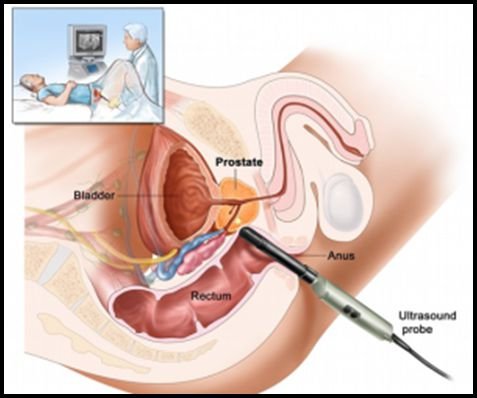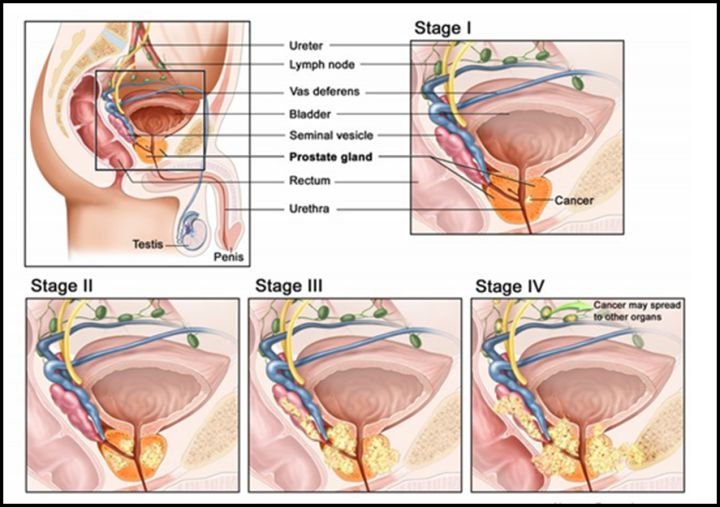Prostate Cancer
Prostate Cancer
Prostate cancer is a disease in which malignant (cancer) cells form in the tissues of the prostate. Prostate cancer is found mainly in older men. As men age, the prostate may get bigger and block the urethra or bladder. This may cause difficulty in urination or can interfere with sexual function. The condition is called benign prostatic hyperplasia (BPH), and although it is not cancer, surgery may be needed to correct it. The symptoms of benign prostatic hyperplasia or of other problems in the prostate may be similar to symptoms of prostate cancer.
Possible signs of prostate cancer include:
These and other symptoms may be caused by prostate cancer. Other conditions may cause the same symptoms. A doctor should be consulted if any of the following problems occur:
- Week or interrupted flow of urine.
- Frequent urination.
- Trouble urinating.
- Pain or burning during urination.
- Blood in the urine or seman.
- A pain in the back, hips, or pelvis that doesn’t go away.
- Painful ejaculation.
Tests that examine the prostate and blood are used to detect (find) and diagnose prostate cancer.
The following tests and procedures may be used:
Digital rectal exam (DRE): An exam of the rectum. The doctor or nurse inserts a lubricated, gloved finger into the rectum and feels the prostate through the rectal wall for lumps or abnormal areas.

Prostate-specific antigen (PSA) test: A test that measures the level of PSA in the blood. PSA is a substance made by the prostate that may be found in an increased amount in the blood of men who have prostate cancer. PSA levels may also be high in men who have an infection or inflammation of the prostate or BPH (an enlarged, but noncancerous, prostate).
Transrectal ultrasound: A procedure in which a probe that is about the size of a finger is inserted into the rectum to check the prostate. The probe is used to bounce high-energy sound waves (ultrasound) off internal tissues or organs and make echoes. The echoes form a picture of body tissues called a sonogram. Transrectal ultrasound may be used during a biopsy procedure.

Biopsy: The removal of cells or tissues so they can be viewed under a microscope by a pathologist. The pathologist will examine the biopsy sample to check for cancer cells and determine the Gleason score. The Gleason score ranges from 2-10 and describes how likely it is that a tumor will spread. The lower the number, the less likely the tumor is to spread. There are 2 types of biopsy procedures used to diagnose prostate cancer:
Transrectal biopsy: The removal of tissue from the prostate by inserting a thin needle through the rectum and into the prostate. This procedure is usually done using transrectal ultrasound to help guide the needle. A pathologist views the tissue under a microscope to look for cancer cells.
Certain factors affect prognosis (chance of recovery) and treatment options.
The prognosis (chance of recovery) and treatment options depend on the following:
- The stage of the cancer (whether it affects part of the prostate, involves the whole prostate, or has spread to other places in the body).
- The patient’s age and health.
- Whether the cancer has just been diagnosed or has recurred (come back).
Prognosis also depends on the Gleason score and the level of PSA
After prostate cancer has been diagnosed, tests are done to find out if cancer cells have spread within the prostate or to other parts of the body.
The process used to find out if cancer has spread within the prostate or to other parts of the body is called staging. The information gathered from the staging process determines the stage of the disease. It is important to know the stage in order to plan treatment. The following tests and procedures may be used in the staging processs
- Radionuclide bone scan: A procedure to check if there are rapidly dividing cells, such as cancer cells, in the bone. A very small amount of radioactive material is injected into a vein and travels through the bloodstream. The radioactive material collects in the bones and is detected by a scanner.
- MRI (magnetic resonance imaging): A procedure that uses a magnet, radio waves, and a computer to make a series of detailed pictures of areas inside the body. This procedure is also called nuclear magnetic resonance imaging (NMRI).
- Pelvic lymphadenectomy: A surgical procedure to remove the lymph nodes in the pelvis. A pathologist views the tissue under a microscope to look for cancer cells.
- CT scan (CAT scan): A procedure that makes a series of detailed pictures of areas inside the body, taken from different angles. The pictures are made by a computer linked to an x-ray machine. A dye may be injected into a vein or swallowed to help the organs or tissues show up more clearly. This procedure is also called computed tomography, computerized tomography, or computerized axial tomography.
- Seminal vesicle biopsy: The removal of fluid from the seminal vesicles (glands that produce semen) using a needle. A pathologist views the fluid under a microscope to look for cancer cells.
The stage of the cancer is based on the results of the staging and diagnostic tests, including the original tumor biopsy. The biopsy is used to determine the Gleason score. The Gleason score ranges from 2-10 and describes how different the cancer cells look from normal cells and how likely it is that the tumor will spread. The lower the number, the less likely the tumor is to spread.

Stage I
In stage I, cancer is found in the prostate only. It cannot be felt during a digital rectal exam and is not visible by imaging. It is usually found accidentally during surgery for other reasons, such as benign prostatic hyperplasia. The Gleason score is low. Stage I prostate cancer may also be called stage A1 prostate cancer.
Stage II
In stage II, cancer is more advanced than in stage I, but has not spread outside the prostate. The Gleason score can range from 2-10. Stage II prostate cancer may also be called stage A2, stage B1, or stage B2 prostate cancer.
Stage III
In stage III, cancer has spread beyond the outer layer of the prostate to nearby tissues. Cancer may be found in the seminal vesicles. The Gleason score can range from 2-10. Stage III prostate cancer may also be called stage C prostate cancer.
Stage IV
In stage IV, cancer has metastasized (spread) to lymph nodes near or far from the prostate or to other parts of the body, such as the bladder, rectum, bones, liver, or lungs. Metastatic prostate cancer often spreads to the bones. The Gleason score can range from 2-10. Stage IV prostate cancer may also be called stage D1 or stage D2 prostate cancer.
Treatment Option Overview
There are different types of treatment for patients with prostate cancer.
Different types of treatment are available for patients with prostate cancer. Some treatments are standard (the currently used treatment), and some are being tested in clinical trials. Before starting treatment, patients may want to think about taking part in a clinical trial. A treatment clinical trial is a research study meant to help improve current treatments or obtain information on new treatments for patients with cancer. When clinical trials show that a new treatment is better than the standard treatment, the new treatment may become the standard treatment.
Four types of standard treatment are used:
Watchful Waiting
Watchful waiting is closely monitoring a patient’s condition without giving any treatment until symptoms appear or change. This is usually used in older men with other medical problems and early-stage disease.
Surgery
Patients in good health are usually offered surgery as treatment for prostate cancer. The following types of surgery are used:
- Pelvic lymphadenectomy: A surgical procedure to remove the lymph nodes in the pelvis. A pathologist views the tissue under a microscope to look for cancer cells. If the lymph nodes contain cancer, the doctor will not remove the prostate and may recommend other treatment.
- Radical prostatectomy: A surgical procedure to remove the prostate, surrounding tissue, and seminal vesicles. There are 2 types of radical prostatectomy:
- Retropubic prostatectomy: A surgical procedure to remove the prostate through an incision (cut) in the abdominal wall. Removal of nearby lymph nodes may be done at the same time.
- Perineal prostatectomy: A surgical procedure to remove the prostate through an incision (cut) made in the perineum (area between the scrotum and anus). Nearby lymph nodes may also be removed through a separate incision in the abdomen.
Two types of radical prostatectomy. In a retropubic prostatectomy, the prostate is removed through an incision in the wall of the abdomen. In a perineal prostatectomy, the prostate is removed through an incision in the area between the scrotum and the anus.

Transurethral resection of the prostate (TURP): A surgical procedure to remove tissue from the prostate using a resectoscope (a thin, lighted tube with a cutting tool) inserted through the urethra. This procedure is sometimes done to relieve symptoms caused by a tumor before other cancer treatment is given. Transurethral resection of the prostate may also be done in men who cannot have a radical prostatectomy because of age or illness.
Transurethral resection of the prostate (TURP). Tissue is removed from the prostate using a resectoscope (a thin, lighted tube with a cutting tool at the end) inserted through the urethra. Prostate tissue that is blocking the urethra is cut away and removed through the resectoscope.
Impotence and leakage of urine from the bladder or stool from the rectum may occur in men treated with surgery. In some cases, doctors can use a technique known as nerve-sparing surgery. This type of surgery may save the nerves that control erection. However, men with large tumors or tumors that are very close to the nerves may not be able to have this surgery.
Radiation Therapy
Radiation therapy is a cancer treatment that uses high-energy x-rays or other types of radiation to kill cancer cells or keep them from growing. There are two types of radiation therapy. External radiation therapy uses a machine outside the body to send radiation toward the cancer. Internal radiation therapy uses a radioactive substance sealed in needles, seeds, wires, or catheters that are placed directly into or near the cancer. The way the radiation therapy is given depends on the type and stage of the cancer being treated.
Impotence and urinary problems may occur in men treated with radiation therapy.
Hormone Therapy
Hormone therapy is a cancer treatment that removes hormones or blocks their action and stops cancer cells from growing. Hormones are substances produced by glands in the body and circulated in the bloodstream. Some hormones can cause certain cancers to grow. If tests show that the cancer cells have places where hormones can attach (receptors), drugs, surgery, or radiation therapy are used to reduce the production of hormones or block them from working.
Hormone therapy used in the treatment of prostate cancer may include the following:
- Luteinizing hormone-releasing hormone agonists can prevent the testicles from producing testosterone. Examples are leuprolide, goserelin, and buserelin.
- Antiandrogens can block the action of androgens (hormones that promote male sex characteristics). Two examples are flutamide and nilutamide.
- Drugs that can prevent the adrenal glands from making androgens include ketoconazole and aminoglutethimide.
- Orchiectomy is a surgical procedure to remove one or both testicles, the main source of male hormones, to decrease hormone production.
- Estrogens (hormones that promote female sex characteristics) can prevent the testicles from producing testosterone. However, estrogens are seldom used today in the treatment of prostate cancer because of the risk of serious side effects.
Hot flashes, impaired sexual function, loss of desire for sex, and weakened bones may occur in men treated with hormone therapy.
New types of treatment are being tested in clinical trials. These include the following:
Cryosurgery
Cryosurgery is a treatment that uses an instrument to freeze and destroy prostate cancer cells. This type of treatment is also called cryotherapy. Video Dr. Garo Tartzakain – St. Joseph’s Hospital -discusses cryotherapy treatment.
Chemotherapy
Chemotherapy is a cancer treatment that uses drugs to stop the growth of cancer cells, either by killing the cells or by stopping them from dividing. When chemotherapy is taken by mouth or injected into a vein or muscle, the drugs enter the bloodstream and can reach cancer cells throughout the body (systemic chemotherapy). When chemotherapy is placed directly into the spinal column, an organ, or a body cavity such as the abdomen, the drugs mainly affect cancer cells in those areas (regional chemotherapy). The way the chemotherapy is given depends on the type and stage of the cancer being treated.
Biologic therapy
Biologic therapy is a treatment that uses the patients immune system to fight cancer. Substances made by the body or made in a laboratory are used to boost, direct, or restore the bodys natural defenses against cancer. This type of cancer treatment is also called biotherapy or immunotherapy.
High-intensity focused ultrasound
High-intensity focused ultrasound is a treatment that uses ultrasound (high-energy sound waves) to destroy cancer cells. To treat prostate cancer, an endorectal probe is used to make the sound waves.
